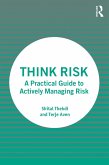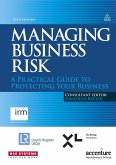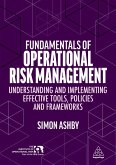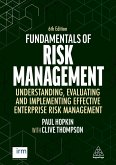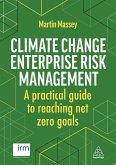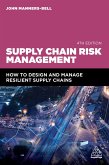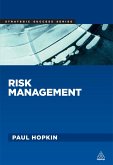Liz Taylor
Practical Enterprise Risk Management (eBook, ePUB)
How to Optimize Business Strategies Through Managed Risk Taking
33,95 €
33,95 €
inkl. MwSt.
Sofort per Download lieferbar

17 °P sammeln
33,95 €
Als Download kaufen

33,95 €
inkl. MwSt.
Sofort per Download lieferbar

17 °P sammeln
Jetzt verschenken
Alle Infos zum eBook verschenken
33,95 €
inkl. MwSt.
Sofort per Download lieferbar
Alle Infos zum eBook verschenken

17 °P sammeln
Liz Taylor
Practical Enterprise Risk Management (eBook, ePUB)
How to Optimize Business Strategies Through Managed Risk Taking
- Format: ePub
- Merkliste
- Auf die Merkliste
- Bewerten Bewerten
- Teilen
- Produkt teilen
- Produkterinnerung
- Produkterinnerung

Bitte loggen Sie sich zunächst in Ihr Kundenkonto ein oder registrieren Sie sich bei
bücher.de, um das eBook-Abo tolino select nutzen zu können.
Hier können Sie sich einloggen
Hier können Sie sich einloggen
Sie sind bereits eingeloggt. Klicken Sie auf 2. tolino select Abo, um fortzufahren.

Bitte loggen Sie sich zunächst in Ihr Kundenkonto ein oder registrieren Sie sich bei bücher.de, um das eBook-Abo tolino select nutzen zu können.
Practical Enterprise Risk Management addresses the real need for organizations to take more managed risks in order to maximize business strategies and achieve long term goals. Based on ISO 31000 and applying current best practice, it provides templates and examples that can be adapted for any industry. Breaking down the theory on enterprise risk management, it helps you see risk as both an opportunity and a threat whilst giving you guidance on how to implement it. It provides models for Risk Adjusted Return on Capital to evaluate R.O.I and measure performance, advice on emergent risks, as…mehr
- Geräte: eReader
- mit Kopierschutz
- eBook Hilfe
- Größe: 2.45MB
- FamilySharing(5)
Andere Kunden interessierten sich auch für
![Think Risk (eBook, ePUB) Think Risk (eBook, ePUB)]() Shital ThekdiThink Risk (eBook, ePUB)44,95 €
Shital ThekdiThink Risk (eBook, ePUB)44,95 €![Managing Business Risk (eBook, ePUB) Managing Business Risk (eBook, ePUB)]() Jonathan ReuvidManaging Business Risk (eBook, ePUB)55,95 €
Jonathan ReuvidManaging Business Risk (eBook, ePUB)55,95 €![Fundamentals of Operational Risk Management (eBook, ePUB) Fundamentals of Operational Risk Management (eBook, ePUB)]() Simon AshbyFundamentals of Operational Risk Management (eBook, ePUB)38,95 €
Simon AshbyFundamentals of Operational Risk Management (eBook, ePUB)38,95 €![Fundamentals of Risk Management (eBook, ePUB) Fundamentals of Risk Management (eBook, ePUB)]() Clive ThompsonFundamentals of Risk Management (eBook, ePUB)39,95 €
Clive ThompsonFundamentals of Risk Management (eBook, ePUB)39,95 €![Climate Change Enterprise Risk Management (eBook, ePUB) Climate Change Enterprise Risk Management (eBook, ePUB)]() Martin MasseyClimate Change Enterprise Risk Management (eBook, ePUB)33,95 €
Martin MasseyClimate Change Enterprise Risk Management (eBook, ePUB)33,95 €![Supply Chain Risk Management (eBook, ePUB) Supply Chain Risk Management (eBook, ePUB)]() John Manners-BellSupply Chain Risk Management (eBook, ePUB)42,95 €
John Manners-BellSupply Chain Risk Management (eBook, ePUB)42,95 €![Risk Management (eBook, ePUB) Risk Management (eBook, ePUB)]() Paul HopkinRisk Management (eBook, ePUB)25,95 €
Paul HopkinRisk Management (eBook, ePUB)25,95 €-
-
-
Practical Enterprise Risk Management addresses the real need for organizations to take more managed risks in order to maximize business strategies and achieve long term goals. Based on ISO 31000 and applying current best practice, it provides templates and examples that can be adapted for any industry. Breaking down the theory on enterprise risk management, it helps you see risk as both an opportunity and a threat whilst giving you guidance on how to implement it. It provides models for Risk Adjusted Return on Capital to evaluate R.O.I and measure performance, advice on emergent risks, as well as best practice and advice on risk communication, transparency and protecting the brand.
Including a comprehensive overview of risk management responsibilities for boards, Practical Enterprise Risk Management lifts the lid on the whole process, helping you to embed ERM into your organization, reach your goals and take more, and more effective, managed risks.
Including a comprehensive overview of risk management responsibilities for boards, Practical Enterprise Risk Management lifts the lid on the whole process, helping you to embed ERM into your organization, reach your goals and take more, and more effective, managed risks.
Produktdetails
- Produktdetails
- Verlag: Kogan Page eBook
- Seitenzahl: 328
- Erscheinungstermin: 3. Juni 2014
- Englisch
- ISBN-13: 9780749470548
- Artikelnr.: 41007797
- Verlag: Kogan Page eBook
- Seitenzahl: 328
- Erscheinungstermin: 3. Juni 2014
- Englisch
- ISBN-13: 9780749470548
- Artikelnr.: 41007797
- Herstellerkennzeichnung Die Herstellerinformationen sind derzeit nicht verfügbar.
Liz Taylor is a highly regarded practitioner in Enterprise Risk Management industries, with 35 years experience. She was formerly Chief Executive of ALARM (the Forum for Risk Management in the Public Sector), Senior Vice President for Marsh Europe and winner of Europe-wide Risk Management of the year. Currently running her own training and consulting company, Liz Taylor Risk Consulting, she is a Fellow of the Institute of Risk Management as well as the Business Continuity Institute.
Foreword by Steve Fowler
Foreword by Mrutyunjay Mahapatra
Acknowledgements
01 Introduction
Outline
Business is about taking risk
The difference between taking managed and unmanaged risks
Benefits of well-managed enterprise risk management
The myths about risk
Capacity to take risk
Questions for senior management and the board to ask
Notes
02 About enterprise risk management
Outline
Risk management
Implementing the programme for ERM
ERM - the process
Essential attributes of ERM for delivering value and capacity
Top level leadership in ERM
Identifying risk: types of risk, risk lists and taxonomies
Evaluating and prioritizing risk
Governance, risk and compliance
Questions for senior management and the board to ask
Notes
03 Risk as an opportunity/threat to objectives and value drivers
Outline
Risk - opportunities and threats
Risk as uncertainty
Threat and opportunity management
Dealing with threat
Dealing with opportunity
Differentiating between objectives, strategic goals and value drivers
Questions for senior management and the board to ask
Notes
04 Implementing an ERM programme
Outline
Establish the foundation - the operating model for ERM
Documentation for ERM
Language, oversight and governance
Building capabilities: assess and develop responses and capabilities
Improving capabilities: monitoring and communication
Questions for senior management and the board to ask
05 Risk attitude, risk propensity and risk appetite
Outline
Risk aversion versus risk hungry
Applications of a risk appetite tool
Risk capacity versus tolerance
Developing risk appetite frameworks
The risk of not taking a risk
Risk appetite and value drivers
Organization behind the setting of risk appetite
Examples of risk appetite statements
Questions for senior management and the board to ask
Notes
06 ERM culture, blame, boundaries and elephants in the room
Outline
ERM cultures and the blame culture
Using risk appetite as a tool to destroy the blame culture
Managing risk
The link between managed risk taking, mice, Maslow and Herzberg
The elephant in the room and conduct risk
In the public interest
Questions for senior management and the board to ask
Notes
07 Embedding and integrating ERM
Outline
What does embedding mean?
Main aspects of embedding ERM
A 16-step plan for embedding ERM
The three lines of play
Questions for senior management and the board to ask
Notes
08 Maturity in enterprise risk management
Outline
How risk maturity enables managed risk taking
Action plan for measuring and tracking performance
Questions for senior management and the board to ask
Notes
09 Resilience and sustainable habits
Outline
Business continuity management
The role of senior management
Corporate social responsibility
Questions for senior management and the board to ask
Notes
10 Learning and communication
Outline
The learning habit
ERM information systems
External communication
Questions for senior management and the board to ask
Notes
11 Conformance, performance, roles, responsibilities and regulations
Outline
Managing conformance versus performance
The role of boards in ERM
Governance for ERM
The role of internal and external audit in ERM
Compliance requirements for risk management: various countries and
industries
Questions for senior management and the board to ask
Notes
12 Deliverables from quantitative ERM approaches
Outline
Measuring and valuing
Models for valuing risk and capital
Own risk and solvency assessments - a useful model
Stress testing and reverse stress testing
Risks that cannot be valued
Questions for senior management and the board to ask
Notes
13 Simple, elegant ERM tools for senior management
Outline
The triangle of risk - trigger, environment, strength or weakness
Using cause and consequence analysis to transform risk approach
Macro and micro risk management
Questions for senior management and the board to ask
Note
14 ERM and performance management synergies
Outline
Risk management alignment within the organization
Performance management
Performance management methods
Questions for senior management and the board to ask
Notes
15 The key strategic questions for senior management and boards to ask
themselves
Outline
Recognizing the risks of versus the risks to the strategic plan
The key strategic questions
Summary
Appendix 1. Examples of corporate governance and ERM regulations
Appendix 2. The main principles of the UK Code of Governance, October 2012
Appendix 3. Summary COSO guidance
Appendix 4. Case study: Applying a more granular mathematical model to a
risk for a non-financial organization
Appendix 5. Capital and risk considerations for US insurers, from NAIC ORSA
Guidance
Appendix 6. Sample terms of reference for a board risk committee
Appendix 7. Example of roles of CRO and ERM team
Further Reading
Index
Foreword by Mrutyunjay Mahapatra
Acknowledgements
01 Introduction
Outline
Business is about taking risk
The difference between taking managed and unmanaged risks
Benefits of well-managed enterprise risk management
The myths about risk
Capacity to take risk
Questions for senior management and the board to ask
Notes
02 About enterprise risk management
Outline
Risk management
Implementing the programme for ERM
ERM - the process
Essential attributes of ERM for delivering value and capacity
Top level leadership in ERM
Identifying risk: types of risk, risk lists and taxonomies
Evaluating and prioritizing risk
Governance, risk and compliance
Questions for senior management and the board to ask
Notes
03 Risk as an opportunity/threat to objectives and value drivers
Outline
Risk - opportunities and threats
Risk as uncertainty
Threat and opportunity management
Dealing with threat
Dealing with opportunity
Differentiating between objectives, strategic goals and value drivers
Questions for senior management and the board to ask
Notes
04 Implementing an ERM programme
Outline
Establish the foundation - the operating model for ERM
Documentation for ERM
Language, oversight and governance
Building capabilities: assess and develop responses and capabilities
Improving capabilities: monitoring and communication
Questions for senior management and the board to ask
05 Risk attitude, risk propensity and risk appetite
Outline
Risk aversion versus risk hungry
Applications of a risk appetite tool
Risk capacity versus tolerance
Developing risk appetite frameworks
The risk of not taking a risk
Risk appetite and value drivers
Organization behind the setting of risk appetite
Examples of risk appetite statements
Questions for senior management and the board to ask
Notes
06 ERM culture, blame, boundaries and elephants in the room
Outline
ERM cultures and the blame culture
Using risk appetite as a tool to destroy the blame culture
Managing risk
The link between managed risk taking, mice, Maslow and Herzberg
The elephant in the room and conduct risk
In the public interest
Questions for senior management and the board to ask
Notes
07 Embedding and integrating ERM
Outline
What does embedding mean?
Main aspects of embedding ERM
A 16-step plan for embedding ERM
The three lines of play
Questions for senior management and the board to ask
Notes
08 Maturity in enterprise risk management
Outline
How risk maturity enables managed risk taking
Action plan for measuring and tracking performance
Questions for senior management and the board to ask
Notes
09 Resilience and sustainable habits
Outline
Business continuity management
The role of senior management
Corporate social responsibility
Questions for senior management and the board to ask
Notes
10 Learning and communication
Outline
The learning habit
ERM information systems
External communication
Questions for senior management and the board to ask
Notes
11 Conformance, performance, roles, responsibilities and regulations
Outline
Managing conformance versus performance
The role of boards in ERM
Governance for ERM
The role of internal and external audit in ERM
Compliance requirements for risk management: various countries and
industries
Questions for senior management and the board to ask
Notes
12 Deliverables from quantitative ERM approaches
Outline
Measuring and valuing
Models for valuing risk and capital
Own risk and solvency assessments - a useful model
Stress testing and reverse stress testing
Risks that cannot be valued
Questions for senior management and the board to ask
Notes
13 Simple, elegant ERM tools for senior management
Outline
The triangle of risk - trigger, environment, strength or weakness
Using cause and consequence analysis to transform risk approach
Macro and micro risk management
Questions for senior management and the board to ask
Note
14 ERM and performance management synergies
Outline
Risk management alignment within the organization
Performance management
Performance management methods
Questions for senior management and the board to ask
Notes
15 The key strategic questions for senior management and boards to ask
themselves
Outline
Recognizing the risks of versus the risks to the strategic plan
The key strategic questions
Summary
Appendix 1. Examples of corporate governance and ERM regulations
Appendix 2. The main principles of the UK Code of Governance, October 2012
Appendix 3. Summary COSO guidance
Appendix 4. Case study: Applying a more granular mathematical model to a
risk for a non-financial organization
Appendix 5. Capital and risk considerations for US insurers, from NAIC ORSA
Guidance
Appendix 6. Sample terms of reference for a board risk committee
Appendix 7. Example of roles of CRO and ERM team
Further Reading
Index
Foreword by Steve Fowler
Foreword by Mrutyunjay Mahapatra
Acknowledgements
01 Introduction
Outline
Business is about taking risk
The difference between taking managed and unmanaged risks
Benefits of well-managed enterprise risk management
The myths about risk
Capacity to take risk
Questions for senior management and the board to ask
Notes
02 About enterprise risk management
Outline
Risk management
Implementing the programme for ERM
ERM - the process
Essential attributes of ERM for delivering value and capacity
Top level leadership in ERM
Identifying risk: types of risk, risk lists and taxonomies
Evaluating and prioritizing risk
Governance, risk and compliance
Questions for senior management and the board to ask
Notes
03 Risk as an opportunity/threat to objectives and value drivers
Outline
Risk - opportunities and threats
Risk as uncertainty
Threat and opportunity management
Dealing with threat
Dealing with opportunity
Differentiating between objectives, strategic goals and value drivers
Questions for senior management and the board to ask
Notes
04 Implementing an ERM programme
Outline
Establish the foundation - the operating model for ERM
Documentation for ERM
Language, oversight and governance
Building capabilities: assess and develop responses and capabilities
Improving capabilities: monitoring and communication
Questions for senior management and the board to ask
05 Risk attitude, risk propensity and risk appetite
Outline
Risk aversion versus risk hungry
Applications of a risk appetite tool
Risk capacity versus tolerance
Developing risk appetite frameworks
The risk of not taking a risk
Risk appetite and value drivers
Organization behind the setting of risk appetite
Examples of risk appetite statements
Questions for senior management and the board to ask
Notes
06 ERM culture, blame, boundaries and elephants in the room
Outline
ERM cultures and the blame culture
Using risk appetite as a tool to destroy the blame culture
Managing risk
The link between managed risk taking, mice, Maslow and Herzberg
The elephant in the room and conduct risk
In the public interest
Questions for senior management and the board to ask
Notes
07 Embedding and integrating ERM
Outline
What does embedding mean?
Main aspects of embedding ERM
A 16-step plan for embedding ERM
The three lines of play
Questions for senior management and the board to ask
Notes
08 Maturity in enterprise risk management
Outline
How risk maturity enables managed risk taking
Action plan for measuring and tracking performance
Questions for senior management and the board to ask
Notes
09 Resilience and sustainable habits
Outline
Business continuity management
The role of senior management
Corporate social responsibility
Questions for senior management and the board to ask
Notes
10 Learning and communication
Outline
The learning habit
ERM information systems
External communication
Questions for senior management and the board to ask
Notes
11 Conformance, performance, roles, responsibilities and regulations
Outline
Managing conformance versus performance
The role of boards in ERM
Governance for ERM
The role of internal and external audit in ERM
Compliance requirements for risk management: various countries and
industries
Questions for senior management and the board to ask
Notes
12 Deliverables from quantitative ERM approaches
Outline
Measuring and valuing
Models for valuing risk and capital
Own risk and solvency assessments - a useful model
Stress testing and reverse stress testing
Risks that cannot be valued
Questions for senior management and the board to ask
Notes
13 Simple, elegant ERM tools for senior management
Outline
The triangle of risk - trigger, environment, strength or weakness
Using cause and consequence analysis to transform risk approach
Macro and micro risk management
Questions for senior management and the board to ask
Note
14 ERM and performance management synergies
Outline
Risk management alignment within the organization
Performance management
Performance management methods
Questions for senior management and the board to ask
Notes
15 The key strategic questions for senior management and boards to ask
themselves
Outline
Recognizing the risks of versus the risks to the strategic plan
The key strategic questions
Summary
Appendix 1. Examples of corporate governance and ERM regulations
Appendix 2. The main principles of the UK Code of Governance, October 2012
Appendix 3. Summary COSO guidance
Appendix 4. Case study: Applying a more granular mathematical model to a
risk for a non-financial organization
Appendix 5. Capital and risk considerations for US insurers, from NAIC ORSA
Guidance
Appendix 6. Sample terms of reference for a board risk committee
Appendix 7. Example of roles of CRO and ERM team
Further Reading
Index
Foreword by Mrutyunjay Mahapatra
Acknowledgements
01 Introduction
Outline
Business is about taking risk
The difference between taking managed and unmanaged risks
Benefits of well-managed enterprise risk management
The myths about risk
Capacity to take risk
Questions for senior management and the board to ask
Notes
02 About enterprise risk management
Outline
Risk management
Implementing the programme for ERM
ERM - the process
Essential attributes of ERM for delivering value and capacity
Top level leadership in ERM
Identifying risk: types of risk, risk lists and taxonomies
Evaluating and prioritizing risk
Governance, risk and compliance
Questions for senior management and the board to ask
Notes
03 Risk as an opportunity/threat to objectives and value drivers
Outline
Risk - opportunities and threats
Risk as uncertainty
Threat and opportunity management
Dealing with threat
Dealing with opportunity
Differentiating between objectives, strategic goals and value drivers
Questions for senior management and the board to ask
Notes
04 Implementing an ERM programme
Outline
Establish the foundation - the operating model for ERM
Documentation for ERM
Language, oversight and governance
Building capabilities: assess and develop responses and capabilities
Improving capabilities: monitoring and communication
Questions for senior management and the board to ask
05 Risk attitude, risk propensity and risk appetite
Outline
Risk aversion versus risk hungry
Applications of a risk appetite tool
Risk capacity versus tolerance
Developing risk appetite frameworks
The risk of not taking a risk
Risk appetite and value drivers
Organization behind the setting of risk appetite
Examples of risk appetite statements
Questions for senior management and the board to ask
Notes
06 ERM culture, blame, boundaries and elephants in the room
Outline
ERM cultures and the blame culture
Using risk appetite as a tool to destroy the blame culture
Managing risk
The link between managed risk taking, mice, Maslow and Herzberg
The elephant in the room and conduct risk
In the public interest
Questions for senior management and the board to ask
Notes
07 Embedding and integrating ERM
Outline
What does embedding mean?
Main aspects of embedding ERM
A 16-step plan for embedding ERM
The three lines of play
Questions for senior management and the board to ask
Notes
08 Maturity in enterprise risk management
Outline
How risk maturity enables managed risk taking
Action plan for measuring and tracking performance
Questions for senior management and the board to ask
Notes
09 Resilience and sustainable habits
Outline
Business continuity management
The role of senior management
Corporate social responsibility
Questions for senior management and the board to ask
Notes
10 Learning and communication
Outline
The learning habit
ERM information systems
External communication
Questions for senior management and the board to ask
Notes
11 Conformance, performance, roles, responsibilities and regulations
Outline
Managing conformance versus performance
The role of boards in ERM
Governance for ERM
The role of internal and external audit in ERM
Compliance requirements for risk management: various countries and
industries
Questions for senior management and the board to ask
Notes
12 Deliverables from quantitative ERM approaches
Outline
Measuring and valuing
Models for valuing risk and capital
Own risk and solvency assessments - a useful model
Stress testing and reverse stress testing
Risks that cannot be valued
Questions for senior management and the board to ask
Notes
13 Simple, elegant ERM tools for senior management
Outline
The triangle of risk - trigger, environment, strength or weakness
Using cause and consequence analysis to transform risk approach
Macro and micro risk management
Questions for senior management and the board to ask
Note
14 ERM and performance management synergies
Outline
Risk management alignment within the organization
Performance management
Performance management methods
Questions for senior management and the board to ask
Notes
15 The key strategic questions for senior management and boards to ask
themselves
Outline
Recognizing the risks of versus the risks to the strategic plan
The key strategic questions
Summary
Appendix 1. Examples of corporate governance and ERM regulations
Appendix 2. The main principles of the UK Code of Governance, October 2012
Appendix 3. Summary COSO guidance
Appendix 4. Case study: Applying a more granular mathematical model to a
risk for a non-financial organization
Appendix 5. Capital and risk considerations for US insurers, from NAIC ORSA
Guidance
Appendix 6. Sample terms of reference for a board risk committee
Appendix 7. Example of roles of CRO and ERM team
Further Reading
Index

